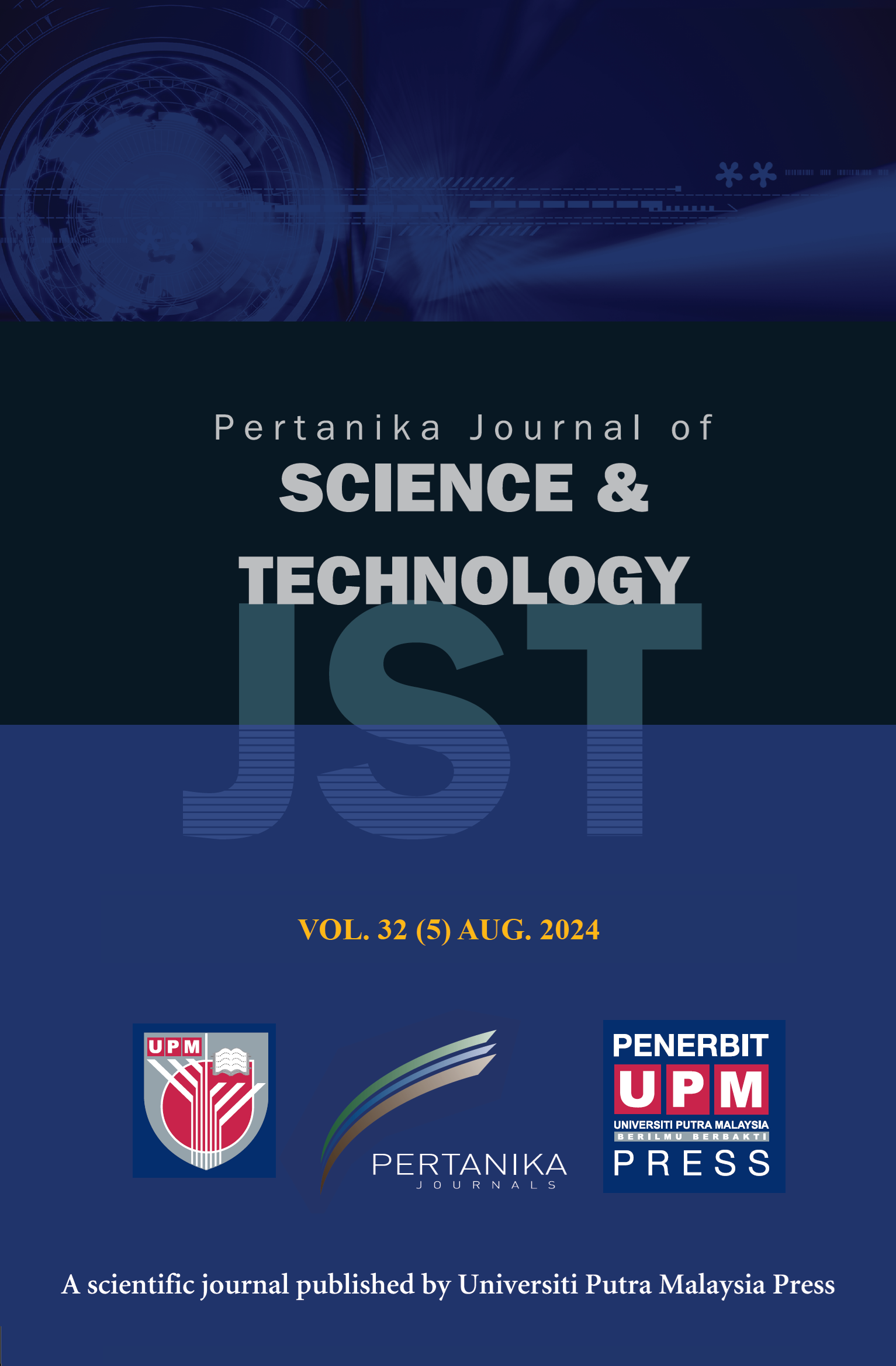PERTANIKA JOURNAL OF SCIENCE AND TECHNOLOGY
e-ISSN 2231-8526
ISSN 0128-7680
J
J
Pertanika Journal of Science & Technology, Volume J, Issue J, January J
Keywords: J
Published on: J
J
-
Abdullah, K., Noor, N. M., & Wok, S. (2008). The perceptions of women’s roles and progress: A study of Malay women. Social Indicators Research, 89(3), 439-455. https://doi.org/10.1007/s11205-008-9242-7
-
Abu Bakar, N. R. H. (2009). Faktor-faktor yang mempengaruhi segregasi pekerjaan mengikut gender di Malaysia: Satu ilustrasi mikro dari Seremban, Negeri Sembilan [Factors that influence the gender segregation in work force: A micro illustration from Seremban, Negeri Sembilan]. Geografia-Malaysian Journal of Society and Space, 5(2), 45-54.
-
Bianchi, S. M., Milkie, M. A., Sayer, L. C., & Robinson, J. P. (2000). Is anyone doing the housework? Trends in the gender division of household labor. Social Forces, 79(1), 191-228. https://doi.org/10.2307/2675569
-
Bianchi, S. M., & Raley, S. B. (2005). Time allocation in families. In S. M. Bianchi, L. M. Casper, & R. B. King (Eds.), Work, family, health, and well-being. Taylor & Francis.
-
Bittman, M., England, P., Folbre, N., Sayer, L., & Matheson, G. (2003). When does gender trump money? Bargaining and time in household work. American Journal of Sociology, 109(1), 186–214. https://doi.org/10.1086/378341
-
Boo, H. S. (2018). Ethnicity and religiosity in the gender division of housework and childcare in Malay and Chinese households in Malaysia [Doctoral Dissertation, University of New South Wales]. https://unsworks.unsw.edu.au/fapi/datastream/unsworks:51104/SOURCE2?view=true
-
Choong, C., Firouz, A. M. M., Jasmin, A. F., Noor, N. M., & Gong, R. (2019). Time to care: Gender inequality, unpaid care work and Time Use Survey. Khazanah Research Institute.
-
Choong, C., & Tan, T. T. (2018). The unsung labour: Care migration in Malaysia. Khazanah Research Institute.
-
Cochran, W. G. (1977). Sampling techniques (3rd ed.). Wiley.
-
Coltrane, S. (2000). Research on household labor: Modeling and measuring the social embeddedness of routine family work. Journal of Marriage and Family, 62(4), 1208-1233. https://doi.org/10.1111/j.1741-3737.2000.01208.x
-
Connell, R. W. (2009). Gender: An introduction (2nd ed.). Polity, London.
-
Coverman, S. (1985). Explaining husbands’ participation in domestic labor. The Sociological Quarterly, 26(1), 81-97. https://doi.org/10.1111/j.1533-8525.1985.tb00217.x
-
Craig, L., & Churchill, B. (2020). Working and caring at home: Gender differences in the effects of Covid-19 on paid and unpaid labor in Australia. Feminist Economics. https://doi.org/10.1080/13545701.2020.1831039
-
Cunningham, M. (2001). Parental influences on the gendered division of housework. American Sociological Review, 66(2), 184-203. https://doi.org/10.2307/2657414
-
DaVanzo, J., & Lee, D. L. P. (1978). The compatibility of child care with labor force participation and nonmarket activities: Preliminary evidence from Malaysian Time Budget Data. RAND Corporation.
-
Department of Statistics Malaysia. (2019). Labour force survey report. https://www.dosm.gov.my/v1/index.php?r=column/pdfPrev&id=TlVMbEtBVXBGTi80VjdqZ1JUdVRHdz09
-
Department of Statistics Malaysia. (2020a). Current population estimates, Malaysia 2020. https://www.dosm.gov.my/v1/index.php?r=column/cthemeByCat&cat=155&bul_id=OVByWjg5YkQ3MWFZRTN5bDJiaEVhZz09&menu_id=L0pheU43NWJwRWVSZklWdzQ4TlhUUT09
-
Department of Statistics Malaysia. (2020b). Report of special survey on effects of COVID-19 on economy & individual (Round 1). https://www.dosm.gov.my/v1/index.php?r=column/cone&menu_id=d3pnMXZ4ZHJjUnpnYjNyUnJhek83dz09
-
Epstein, M., & Ward, L. M. (2011). Exploring parent-adolescent communication about gender: Results from adolescent and emerging adult samples. Sex Roles, 65(1), 108-118. https://doi.org/10.1007/s11199-011-9975-7
-
Hewitt, B., Baxter, J., Givans, S., Murphy, M., Myers, P., & Meiklejohn, C. (2011). Men’s engagement in shared care and domestic work in Australia. https://www.dss.gov.au/our-responsibilities/women/publications-articles/economic-independence/mens-engagement-in-shared-care-and-domestic-work-in-australia
-
International Social Survey Programme Research Group. (2016). International social survey programme: Family and changing gender roles IV -ISSP 2012 (ZA5900). https://doi.org/10.4232/1.12661
-
JobStreet Malaysia. (2020). COVID-19 job report. https://www.jobstreet.com.my/en/cms/employer/wp-content/themes/jobstreet-employer/assets/loa/report/my/JobStreet-COVID-19-Job-Report-Malaysia-Sept-2020.pdf
-
Juhari, R., Yaacob, S. N., & Talib, M. A. (2013). Father involvement among Malay Muslims in Malaysia. Journal of Family Issues, 34(2), 208-227. https://doi.org/10.1177/0192513X12461339
-
Kellner, P. (2004). Can online polls produce accurate findings? International Journal of Market Research, 46(1), 3-22. https://doi.org/10.1177/147078530404600102
-
Lachance-Grzela, M., & Bouchard, G. (2010). Why do women do the lion’s share of housework? A decade of research. Sex Roles, 63(11), 767-780. https://doi.org/10.1007/s11199-010-9797-z
-
López-Garza, M. (2002). Convergence of the public and private Spheres: Women in the informal economy. Race, Gender & Class, 9(3), 175-192.
-
Mercado, L., Naciri, M., & Mishra, Y. (2020). Women’s unpaid and underpaid work in the times of COVID-19. UN Women, Asia Pacific. https://asiapacific.unwomen.org/en/news-and-events/stories/2020/06/womens-unpaid-and-underpaid-work-in-the-times-of-covid-19
-
Ministry of Economic Affairs. (2018). Mid-term review of the Eleventh Malaysia Plan 2016-2020. https://www.epu.gov.my/en/economic-developments/development-plans/rmk/mid-term-review-eleventh-malaysia-plan-2016-2020
-
Ministry of Health Malaysia. (2020). Updates on the coronavirus disease 2019 (COVID-19) situation in Malaysia. http://covid-19.moh.gov.my/terkini/062020/situasi-terkini-30-jun-2020/Kenyataan Akhbar KPK COVID-19 (30 Jun 2020) - EN.pdf
-
Ministry of Women, Family and Community Development and the United Nations. (2014). Study to support the development of national policies and programmes to increase and retain the participation of women in the Malaysian labour force: Key findings and recommendations. https://www.my.undp.org/content/malaysia/en/home/library/womens_empowerment/women-in-malaysian-labour-force-study-with-undp-2013.html
-
Ng, C. (1999). Positioning women in Malaysia: Class and gender in an industrializing state. Palgrave Macmillan UK. https://doi.org/10.1007/978-1-349-27420-8_1
-
Noor, N. M. (1999). Roles and women’s well-being: Some preliminary findings from Malaysia. Sex Roles, 41(3), 123-145. https://doi.org/10.1023/A:1018846010541
-
Oakley, A. (1974). Sociology of housework. Pantheon New York.
-
Povera, A., Harun, H. N., & Yuus, A. (2020, June 5). Government announces incentives for working parents. New Straits Times. https://www.nst.com.my/news/nation/2020/06/598209/government-announces-incentives-working-parents
-
Presser, H. B. (1994). Employment schedules among dual-earner spouses and the division of household labor by gender. American Sociological Review, 59(3), 348-364. https://doi.org/10.2307/2095938
-
Prime Minister’s Office of Malaysia. (2020a). Prihatin Rakyat Economic Stimulus Package (PRIHATIN). https://www.pmo.gov.my/2020/03/speech-text-prihatin-esp/
-
Prime Minister’s Office of Malaysia. (2020b). The Prime Minister’s special message on COVID-19. https://www.pmo.gov.my/2020/03/perutusan-khas-yab-perdana-menteri-mengenai-covid-19-16-mac-2020/
-
United Nations Development Programme. (2020). How we worked from home. Report prepared by UNDP Accelerator Lab Malaysia. https://www.undp.org/content/undp/en/home/librarypage/crisis-prevention-and-recovery/how-we-worked-from-home.html
-
United Nations Entity for Gender Equality and the Empowerment of Women. (2020). Surveys show that COVID-19 has gendered effects in Asia and the Pacific | UN Women Data Hub. https://data.unwomen.org/resources/surveys-show-covid-19-has-gendered-effects-asia-and-pacific
ISSN 0128-7680
e-ISSN 2231-8526




